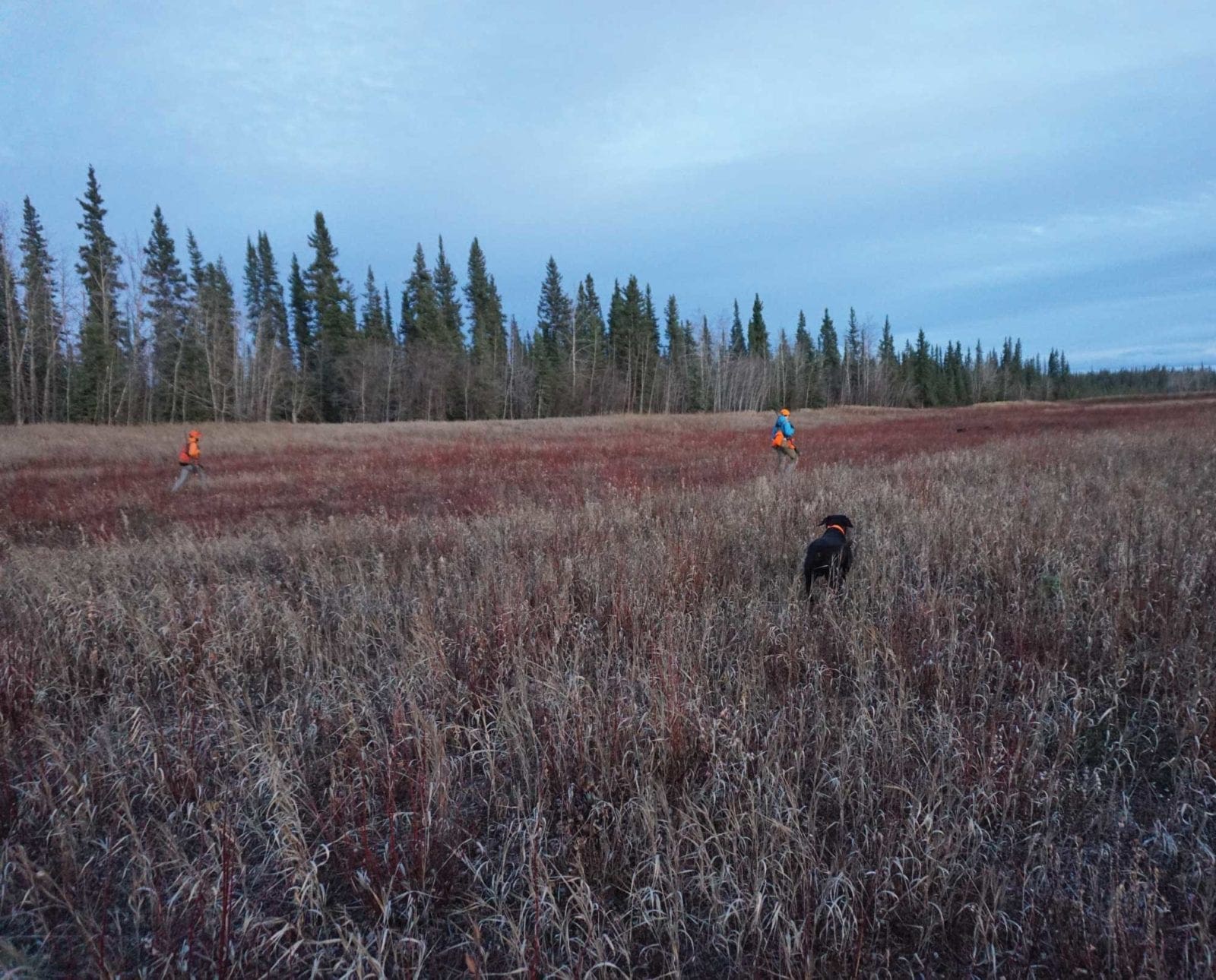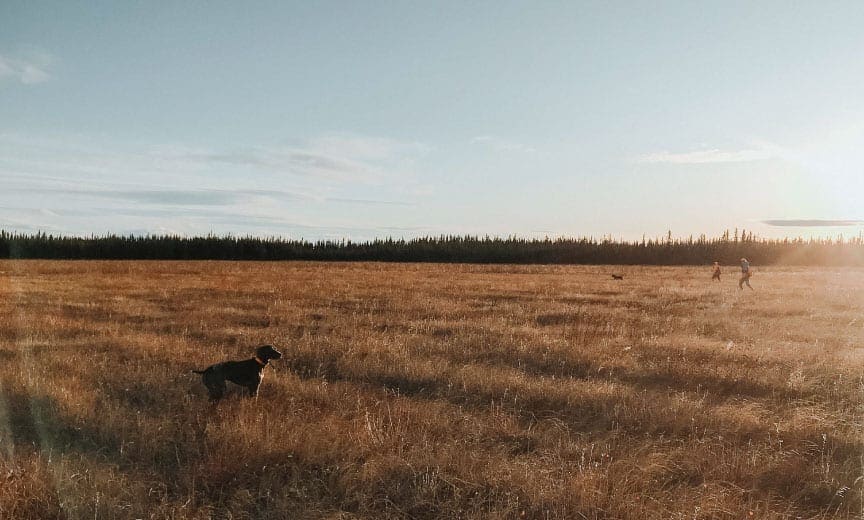Home » Grouse Species » Sharp-tailed Grouse Hunting » Sharptail Hunting Alaska – Finding Fire Birds
Sharptail Hunting Alaska – Finding Fire Birds

Scott Johnson is a first generation hunter with a lifelong…
Exploring the mystery of sharp-tailed grouse hunting in Alaska.
The first time I saw a sharp-tailed grouse in Alaska it ignited a litany of unanswered questions that burned as long as the wildfires that shape their landscape. I was heading back to Anchorage traveling along one of the few remote highways in the state, having spent a few days in Alaska’s interior among the alders and willows pursuing ruffed grouse. I know my grouse pretty well, and the profile of this sharptail stood out like a statue with a message on the side of the highway because nothing about it made sense. At least not to me at the time.
I pulled over a good distance away, not wanting to pressure the bird with my vehicle so I could observe it in the hopes of learning whatever it was willing to share with me. We were surrounded on both sides by a seemingly endless expanse of spruce trees. My knowledge of sharp-tailed grouse habitat stems from my experience with them in the Western states and their vast landscapes of prairie grass and rolling hills, a world that doesn’t exist here in Alaska.
As I tried to reconcile what I knew with what I was seeing, the bird moved to flush, and I scampered out of my van and onto the roof so I could better watch the bird’s escape flight. It rocketed off the highway, skimmed the tops of the spruce trees, and disappeared into a wilderness that was covered in conifers and water. As I got back in the van to resume my drive, I reflected with Watson, my Labrador Retriever, on the whole experience, and we both felt that we knew less than we had before this moment.
It would be an entire year before I would properly understand that encounter. I was only in Alaska seasonally that year, and would spend another fall and winter traveling around the Lower 48 with my bird dog before returning with permanence. I had gotten a pretty good handle on how and where to find ruffed and spruce grouse. I had failed that fall to close on a white-tailed ptarmigan, but I had a pretty good feel for where to find them as well. I had a firm grasp on my fishing destinations for the summer and had even found places to scratch my waterfowling itch.
That lone encounter with the sharptail on the highway stuck with me, if maybe for the sole reason that it just didn’t fit with what I knew. I poured over all the known quantities of sharptails in Alaska. Delta Junction, a small agricultural community in central Alaska, is well known for its consistent sharp-tailed grouse populations that are attracted to its grain fields and tree rows. That area was a long way from where this bird was, and there wasn’t a farm of any kind for countless miles.
As I was reading through research articles the obvious answer in front of me the whole time finally sunk in. When the native peoples of Alaska would speak of “Fire Birds” they weren’t talking about cool old cars. Mother Nature wields a heavy hand in the Last Frontier, and naturally destructive events are the great constant that creates grouse habitat of all kinds. It’s well known that fire creates superb sharp-tailed grouse habitat, and Alaska has thousands upon thousands of acres that burn every year during the wildfire season. I returned to the map of my lone encounter, and immediately noticed that my focus on where that bird went had created an ignorance to where it had been. Just a few hundred yards in the opposite direction five years earlier, there had been a fire that consumed nearly 3,000 acres, rewriting the landscape into a perfect abode for flocks of sharp-tailed grouse.

So that’s it, I had solved the mystery! Later that year as August was coming to an end we would go sharp-tailed grouse hunting. Watson and I headed three hours north out of Anchorage, accompanied by my friend and his golden retriever, along with two more friends and their two young German Shorthaired Pointers. All three of those dogs were in their first seasons, and we would be counting on their youthful energy to help work the large expanse of the field, while Watson’s experience would be counted on to close the gaps and find downed birds.
Our plan was simple: work the field into the wind in the last few hours of the day when the birds should be more active and see what happens. We pulled onto an old gravel turnout, got the dogs ready, spread ourselves out and got to it. We methodically worked over the entire area. Dogs were worked along every edge, near every water source, and the GSPs blanketed the open space leaving no patch of prairie grass or willow untouched.
The ground was remarkably flat and yet still wild, with no even footing under any step. There were many overturned stumps and rutted up patches of ground where a bear had been digging for something it never seemed to find. After hours of work, our dogs were near the end of their day and we were just as tired, with not a single flush to show for it. I called our group together to come up with a plan for our last remaining bit of daylight. The arrogance of my thought that I had this riddle solved was crushed and discarded, and I was confident the grouse had won the day somewhere else in Alaska’s vastness. We had one last patch of ground to hit on our way back to the vehicles, so we half-heartedly set out towards it.
Whether the birds we found had been hiding there the whole time or had moved there around our movements, we’ll never know. Moments into our last walk, Watson lit up with the manner that I know as certainly as anything else, and before we were ready, a sequence of six sharptails burst from the scrubby willow brush. Our shooting wasn’t great, but it was good enough to get a bird for both Watson and Cilo, the young golden retriever.
We gathered to admire our finds, and I was both relieved and excited that we had found them. This certainly wasn’t our first sharp-tailed grouse, but to find them in a place as wild as Alaska feels extra special. As we held our quick little conference, my friend pointed out towards the middle of the field at a sight I had never seen before. In the last hour of daylight, we watched in awe as dozens of sharptails descended upon the field like ducks coming to roost. We made a quick move to get after a small group that had set down in a reachable distance, and after some short work the pair of GSPs locked down on points. After another round of even worse shooting, we managed to bring another pair to the ground, although countless more made it out safely.

We would return to that field once more later in the season, and would find only three grouse holding residency. It seems the more I look for them, Alaska’s sharptails seem more mysterious. They hold many of the same traits as sharptails everywhere else. They dance on leks during their spring courtships, they feed on much of the same forage as their counterparts in the Lower 48, and their manners in the field and on the wing are much the same, right down to the mocking laughter on the flush.
Yet in Alaska, they are intrinsically tied to the unpredictable and wild nature of the landscape. There are no WMAs, hunter access plots, grazing cattle, and almost no agriculture–all constant factors that shape the landscape of sharptails in other areas. In Alaska they are birds of fire, and they go where the fire brings them. Much of that space exists where we’ll never get to them, and they’ll be free to hide and travel in that landscape until we can scratch at them in the few places we can reach.
Scott Johnson is a first generation hunter with a lifelong passion for the outdoors. Originally a fisherman and grouse hunter from Norther Minnesota, he spends his seasons traveling across the country in search of upland birds and waterfowl with his beloved labrador Watson. He hunts and lives out of a converted van that he purpose built for his pursuits, and can be found anywhere from the Midwest to the deserts of Arizona, and as far north as Alaska.




Great read! Thanks!
Relocated from AK to Grand Rapids Mn a year ago. 33 years in AK chasing grouse, sharptail, and ptarmigan.
That was an interesting read by a thoughtful writer. I enjoyed it. Does the fish and game have anyone “up there” that may know more?
Although small game of all varieties takes a back seat to big game and salmon, ADF&G has one small game biologist, Richard Merizon, who does a great job. I’m sure you can find his contact info their website.
Richard works out of the PALMER F&G office.